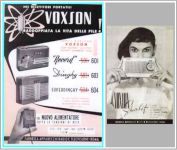 |
Voxson mod. 601 Record Italy - 1955 |
 |
|
 |
 |
 |
 |
 |
 |
 |
 |
|
Italian portable radio with superheterodyne circuit built in the mid-1950s and operating in the Medium Wave range. The circuit uses four miniature valves: DK96, DF96, DAF96 and DL96. The receiver is sensitive and does not need an external antenna because it is equipped with an efficient ferrite antenna. The intermediate frequency is 455 kHz. In this link-1 you can see the electrical diagram while in link-2 you can find the calibration instructions in Italian. Power can be supplied by dry batteries (2 x 1.5 V type D connected in parallel for the filaments and one 67.5 V for the anode) or by mains electricity. Mains power requires an external adapter-transformer (115 - 125 - 140 - 160 - 220 Vac). The AC cable connector acts on the battery-mains switch when inserted. To test the operation of my Voxson 601 item, I made a 63V anode battery by connecting seven 9V 6F22 type batteries in series, inserted in a cardboard casing on which I printed an appropriate image found on the web. Two wires equipped with two crocodile clips, one black and one red, allowed me to connect the anode battery to the original socket. The radio has a nice plastic cabinet with a carrying handle. In the upper left there is the rotary knob for the switch and the volume, in the right part another knob activates the tuning. The speaker grille also functions as a tuning scale. Dimensions: 8.7 x 5.9 x 2.4 inch, and weight: 4 lb 3 oz including batteries. Thanks to Mr. Piercarlo C. for providing this beautiful example of Voxson 601. © IK3HIA, 2009. |
|||
 |
 |
 |
 |
|
|
|||
 |
 |
 |
 |
|
|
|||
 |
 |
 |
 |
 |
 |
 |
 |
 |
 |
 |
 |
Radio portatile italiana con circuito supereterodina prodotta e commercializzata dalla Voxon FARET nella metà degli anni 50 e operante nella gamma delle Onde Medie. Il circuito utilizza quattro valvole miniatura: DK96, DF96, DAF96 e DL96. Il ricevitore e' sensibile e non necessita di antenna esterna perché e' dotato di un'efficiente antenna in ferrite. La media frequenza è a 455 kHz. In questo link-1 è visibile lo schema elettrico mentre nel link-2 ci sono le istruzioni di taratura in italiano. L'alimentazione può essere fornita da batterie a secco (2 da 1.5 V tipo D collegate in parallelo per i filamenti e una da 67,5 V per l'anodica) oppure tramite rete elettrica. L'alimentazione da rete necessita di un adattatore-trasformatore esterno (115 - 125 - 140 - 160 - 220 Vac). Il connettore del cavo AC agisce sul commutatore batterie-rete quando viene inserito. Per verificare il funzionamento del mio esemplare di Voxson 601 ho realizzato una batteria anodica da 63V collegando in serie sette batterie da 9 V tipo 6F22 inserite in un involucro in cartoncino su cui ho stampato un'immagine adeguata rintracciata sul web . Due fili muniti di due coccodrilli uno nero e uno rosso, mi hanno permesso di collegare la batteria anodica alla presa originale. La radio ha un bel mobiletto in plastica con la maniglia per il trasporto. In alto a sinistra c'è la manopola rotante per l'interruttore e il volume, nella parte destra un'altra manopola aziona la sintonia. La griglia dell'altoparlante funziona anche da scala di sintonia. Dimensioni: 22x16x5.5 cm, peso: 1.869 Kg comprese le batterie. Un ringraziamento al Sig. Piercarlo C. per aver procurato il bell'esemplare di Voxson 601. © IK3HIA, 2009. |
|
Return to top of page
|